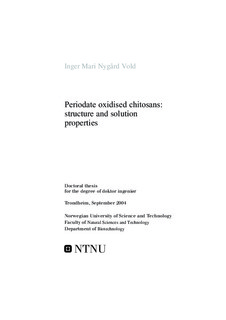| dc.contributor.author | Vold, Inger Mari Nygård | nb_NO |
| dc.date.accessioned | 2014-12-19T13:10:59Z | |
| dc.date.available | 2014-12-19T13:10:59Z | |
| dc.date.created | 2004-10-29 | nb_NO |
| dc.date.issued | 2004 | nb_NO |
| dc.identifier | 126201 | nb_NO |
| dc.identifier.isbn | 82-471-6476-0 | nb_NO |
| dc.identifier.uri | http://hdl.handle.net/11250/244540 | |
| dc.description.abstract | Chitosans are considered promising for a wide range of applications, and especially in the biomedical and pharmaceutical field numerous possible applications are being investigated. However, some of the properties of chitosans are not ideal for biomedical applications. Most high molecular weight chitosans are insoluble near and above physiological pH, limiting its uses. Moreover, the relatively high stiffness of chitosan chains restricts their electrostatic interactions with polyanions. To overcome this problem, chemical modification is an important approach.
The main objective of this work has been to obtain well-characterised modified chitosans with increased solubility and chain flexibility suitable for potential use in biomedical applications, with periodate oxidation being the chosen method of chemically modification.
In order to obtain an improved basis for producing high molecular weight, periodate oxidised chitosans, the kinetics and stoichiometry of the reaction, and the effect of the experimental conditions on the reaction product, were investigated. Chitosans became only partially oxidised during the oxidation with periodate, reaching degrees of oxidation around 0.5, when oxidised with excess periodate. Chitosans were severely depolymerised during the oxidation, and the large overconsumption of periodate observed, can probably be explained by the consumption of periodate at the increasing number of end groups. Free radical mediated depolymerisation seems not to be sufficient to explain the depolymerisation, and a chitosan specific degradation mechanism is probably involved in the depolymerisation. The reaction rates, overconsumption of periodate, and depolymerisation all increased with decreasing FA. No methods to considerably reduce the depolymerisation were found.
The resulting periodate oxidised chitosans were characterised by investigating the chain stiffness, water-solubility and chemical structure. The chain stiffness was measured using size-exclusion chromatography combined with light-scattering and viscosity detectors (SEC-MALLS-VISC), and it was found that the persistent length, q, decreased with increasing degrees of oxidation. The water-solubility of periodate oxidised chitosans with FA = 0.01 and FA = 0.16 increased with increasing degrees of oxidation, and were completely soluble at Fox = 0.10. Chitosans and periodate oxidised chitosans with FA = 0.52 were completely soluble at all pH-values investigated. Thus, periodate oxidised chitosans with increased solubility and chain flexibility were obtained, but the molecular weight could not be retained. The chemical structure was investigated by NMR spectroscopy, but more work remains before any conclusions can be drawn.
The chain stiffness of chitosans with different chemical composition was investigated. Persistence lengths and exponents from double logarithmic plots of [η]-M and RG-M indicate that the chain stiffness is independent of FA, with average q-values of 7 nm, avalues of 0.78 and a’-values 0.56.
To support the methods used and to get a standard of reference the periodate oxidation of alginates, which are more studied than chitosans, was also undertaken and the resulting products characterised. The reaction rates, dPt/dt, in the periodate oxidation of alginates were highly dependent on the type of alginate used and the concentration of the polymer. The chain stiffness was investigated by SEC-MALLS-VISC, and clearly showed that the persistence length decreased with increasing degrees of oxidation.
For use in biomedical applications chitosans have to be pure and well characterised with documented safety profiles. Impurities like metal ion contamination must be strictly controlled. An additional objective of this work was to gain a better understanding of the binding of ions to chitosans, and to develop a method to measure the selective ionbinding properties. A method was successfully developed. No selectivity in the binding of chloride and nitrate ions to chitosan was observed. Molybdate anions were selectively bound to chitosans in the presence of excess nitrate or chloride ions, with selectivity coefficients around 100. Cu2+ ions were bound selectively to chitosan in the presence of Ni2+, Zn2+ or Cd2+ ions, with selectivity coefficients in the range 10 to 1000. Chitosans with low and high FA did not show any difference in their selectivity towards ions. Binding of metal cations increased with pH indicating that only the deprotonised amino groups can bind the ions. | nb_NO |
| dc.language | eng | nb_NO |
| dc.publisher | Fakultet for naturvitenskap og teknologi | nb_NO |
| dc.relation.ispartofseries | Doktoravhandlinger ved NTNU, 1503-8181; 2004:126 | nb_NO |
| dc.relation.haspart | Vold, Inger M. N; Christensen, Bjørn E.. Periodate oxidation of chitosans with different chemical compositions. Carbohydrate Research. 340(4): 679-684, 2005. | nb_NO |
| dc.relation.haspart | Vold, Inger M. N; Christensen, Bjørn E.. A study of the chain stiffness and water-solubility of chitosans and periodate oxidised chitosans. . | nb_NO |
| dc.relation.haspart | Vold, Inger M. N; Christensen, Bjørn E.. Preliminary study on the chemical structure of periodate oxidised chitosans. . | nb_NO |
| dc.relation.haspart | Vold, Inger M. N; Vårum, Kjell M.; Guibal, Eric. Binding of ions to chitosan—selectivity studies. Carbohydrate Polymers. 54: 471-477, 2003. | nb_NO |
| dc.title | Periodate oxidised chitosans : structure and solution properties | nb_NO |
| dc.type | Doctoral thesis | nb_NO |
| dc.contributor.department | Norges teknisk-naturvitenskapelige universitet, Fakultet for naturvitenskap og teknologi | nb_NO |
| dc.description.degree | dr.ing. | nb_NO |
| dc.description.degree | dr.ing. | en_GB |
